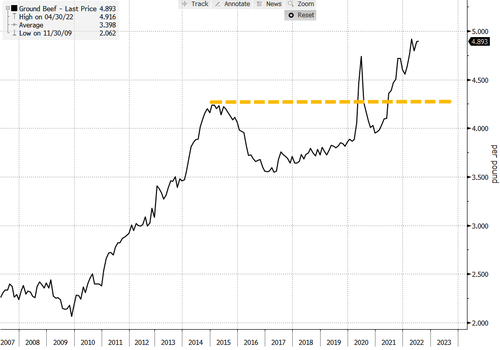Brace For Even Higher Beef Prices As Texas Cattle Industry Faces Historic Drought Crisis
Ranchers across Texas continue to panic sell cattle herds as the worst megadrought in 1,200 years makes it too expensive to sustain operations.
“We’ll keep selling cows till it rains,” Texas High Plains rancher Jim Ferguson told Amarillo station KAMR, which collaborated with The Hill on the expanding cattle crisis in the state.
America’s cattle heartland has seen pastures turn to dust, and costs for feed, fertilizer, and diesel skyrocket, threatening an entire industry that is essential to the nation’s beef supply.
The Hill said that the devastating drought and higher cattle operation costs would result in higher beef prices for at least the next two years. And we agree with that assessment as the latest data via USDA shows supermarket prices surged to record highs earlier this year and are quickly approaching the $5 handle.
“The lack of water in general, it’s hurting us all the way around. Any way you can think of,” cattle buyer Josh Sturgeon said.
Sturgeon said ranchers are liquidating herds at auction because of the lack of water and soaring costs.
But “you’re almost afraid to buy. Cattle drink a lot of water, especially this time of year. With this drought, they’re drinking a lot of water. Cattle are dying because of this. Even the best of cattle are struggling,” he noted.
Walter Kunisch of consultant group Hilltop Securities said increased cattle liquidations at auctions due to worsening drought is “nothing like we’ve seen in the last 15 years.”
Kunisch pointed out that farmers are selling off their breeding stock, which they rely on to produce the next generation of cows.
“That’s a big signal to me that, you know, that future supplies at some point are going to run tight,” Kunsich warned.
USDA’s latest cattle report found herds are down 2.4% nationwide since last year — a decrease of 750,000 cows — and a decline of 2 million since the national herd peaked in 2018.
The biggest takeaway is cattle herds moving forward are expected to shrink, meaning tight supplies and higher prices.
Tyler Durden
Thu, 08/18/2022 – 16:30
via ZeroHedge News https://ift.tt/h1KVk3M Tyler Durden

